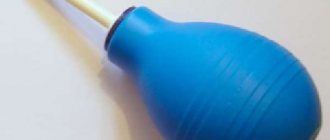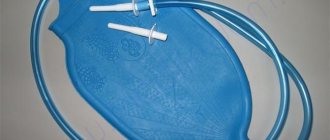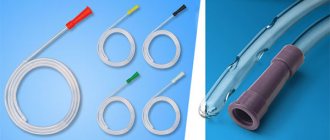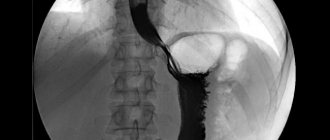Implementation at home
You can perform a cleansing enema both at home and in a medical facility. But still, you should not often use this method of cleansing at home, so as not to harm the intestinal microflora.
It is important to know that a cleansing enema at home must be carried out according to the rules, because the result of cleansing will directly depend on this. Even minor flaws can prevent you from achieving the desired result.
When is it customary to give oil enemas?
An oil enema is a manipulation that can be used to free the intestines from gases and accumulated feces.
An oil enema is considered an effective first aid method for regular constipation - accumulation of feces in the distal intestine.
There are several main indications for performing this type of enemas. They are:
- The recovery period after surgery in the abdominal cavity.
- Inflammatory processes affecting the rectal area.
- The first weeks after childbirth.
- If there is no effect from taking laxatives.
Self-oil enemas are allowed to be performed at home in order to gently cleanse the intestines if the patient cannot defecate on his own.
How does an enema work?
When water begins to gradually fill the stomach, it penetrates through the small intestine and seeps into the area of the large intestine, then gradually puts pressure on it, and this leads to irritation of its walls. At the same time, intestinal peristalsis increases, its walls contract more strongly, after which a person begins to feel the urge to defecate, and the liquid washes away feces and everything unnecessary.
How does an oil enema work?
The effect of oil enemas as laxatives is based on enveloping the intestinal walls with a thin oil film and softening stool . Injected into the rectum, vegetable oil makes them elastic, facilitates the movement of contents through the intestines and facilitates easier emptying.
An additional effect is provided by warm enema liquid, specially heated to room temperature before using the enema. This helps ease bowel movements and relieves intestinal spasms.
Oil enemas have a number of advantages:
- do not penetrate deep into the intestines,
- do not have an irritating effect on him,
- do not violate the algorithm of its operation,
- do not enhance intestinal motility.
To prepare an enema solution, warm (39-40 degrees) oil is used in a volume of 50 ml. up to 100 ml . This volume is quite sufficient to have its impact. The action time is approximately 10-12 hours, after the procedure you need to lie down for a while to let the solution do its job.
Sometimes it's better to see once:
Indications for performing cleansing enemas
A cleansing enema is prescribed if a person is found to be poisoned. An enema is also indicated if the patient often experiences constipation (stool retention for more than 48 hours) and discomfort in the intestinal area. Pregnant women are prescribed cleansing enemas before childbirth, and cleansing is also carried out before surgery or colonoscopy.
There are contraindications for administering enemas:
- rectal tumor;
- rectal prolapse;
- inflammatory and other diseases of the rectum and anus;
- bleeding hemorrhoids.
During pregnancy
During pregnancy, problems with stool often worsen, and natural bowel movements become difficult for several reasons:
- weak motor activity;
- increased levels of progesterone, which relaxes muscles, including the colon;
- eating disorders;
- exacerbation of chronic diseases;
- compression of the intestinal walls by the growing uterus and the growing fetus in it;
- exacerbation of hemorrhoids.
An oil enema, designed to promote the passage of stool, is possible during pregnancy, but undesirable. It can be carried out in consultation with a doctor after other methods have been tried to no avail, and only if there are no contraindications.
Contraindications for performing an enema during pregnancy may include:
- weakness or simply feeling unwell;
- headache;
- nausea and vomiting;
- even a slight increase in temperature;
- stomach ache;
- exacerbation of any chronic diseases;
- vaginal prolapse.
When performing an enema, there is a high probability that the uterus will become toned, which in the early stages can cause a miscarriage.
Milk enema for constipation and flatulence: how to carry out the procedure?
How to do a cleansing enema at home? Read here.
Instructions for microenema Normacol -
Cleansing enema: technique of execution
Photos will help you carry out the process correctly. Setting up an enema contains several stages. First you need to prepare everything you need, and then give the enema itself.
Devices that are necessary for performing cleansing and other enemas:
- Esmarch's mug with a special rubber tube or pear;
- tripod for hanging a mug;
- glass, plastic or ebonite sterile tip;
- clamp;
- vessel, oilcloth (lining), petroleum jelly;
- sterile gloves;
- 1.5-2 liters of boiled water (room temperature water);
- thermometer (for water);
- pelvis;
- patient couch;
- a special basin or container for used tips.
Performing an oil enema
It is best to entrust the oil enema to a healthcare professional. But in the absence of such an opportunity, you can cope with the production at home with the help of one of the household members. This process is quite simple, so it should not cause any difficulties for anyone.
To maximize the effectiveness of the procedure, it is recommended to perform an enema in the evening before bedtime in order to safely empty the intestines in the morning. To avoid unpleasant traces of oil solution on bed linen, it is recommended to cover the bed with a diaper.
Preparation
To administer an oil enema, you need to prepare the appropriate equipment.
- First, you need to purchase an enema or syringe, a gas outlet tube, rubber gloves and oil for the solution at the pharmacy.
- For one procedure you will need 100-200 ml. The oil solution is preheated to 35-37 degrees.
- The tip of the syringe or enema is lubricated with Vaseline.
To avoid possible contraindications or adverse reactions, it is better to avoid mixing different types of oils. In fact, feces do not care at all which oil solution softens and envelops them.
Cooking recipes
You can cope with constipation by using the oil not only in an enema, but also by taking it orally. Such recipes will only enhance the effectiveness of enema when combined.
- Mix a large spoon of lemon juice with a large spoon of vegetable oil and drink at night;
- Drink 2 large tablespoons of oil on an empty stomach, then you can’t eat anything for another hour;
- Add a large spoonful of oil to a glass of yogurt, take three times a day;
- A large spoon of orange juice is mixed with 2 large spoons of oil, taken on an empty stomach in the morning;
- Drink a spoonful of castor oil on an empty stomach in the morning. You can mix it with orange or plum juice;
- Eat more flaxseed oil, season salads with it, etc.
If you combine the intake of oils with oil enemas, the effect will be much greater.
Staging algorithm
So, to perform the enema, we have already prepared the equipment and heated the required amount of oil solution (50-100 ml).
- You need to fill the bulb with an enema solution, i.e. heated oil.
- Now you need to lubricate the tip of the gas outlet tube and insert it into the anus of the patient lying on his left side.
- Connect the syringe to the tube and pour oil through it into the rectum.
- Without unclenching the bulb, disconnect it from the gas outlet tube, then pull out the tube itself.
To avoid leakage of the solution, it is recommended to lie on your side for at least half an hour so that the oil solution spreads throughout the intestines and begins to work fully, softening the feces. Usually, emptying occurs 6-12 hours after administration of the solution, so the procedure is done at night.
Cleansing enema. Technique performed in a hospital
- Esmarch's mug needs to be filled with water, 1.5-2 liters (temperature 18-22 degrees). Air is released from the system and a clamp is applied. The mug is suspended on a tripod at a level of one to one and a half meters above the couch with the patient.
- A sterile tip is placed on the end of the rubber tube and lubricated with Vaseline.
- An oilcloth is placed on the couch under the patient.
- The patient lies on his left side, bends his knees.
- The medical worker puts on sterile disposable gloves, spreads the patient's buttocks with his hands and carefully inserts the tip into the rectum with a slight rotational movement to a depth of three to four centimeters towards the navel. Then, using the same movements, turn the tube up to 8-10 centimeters towards the tailbone.
- The clamp on the rubber tube is removed, and water (1-2 liters) is gradually poured into the rectum.
- To prevent air from entering the intestines, a little water is left at the bottom of the mug.
- Before removing the tip, a clamp is applied to the tube.
- The tip is removed with a slight rotational movement in the reverse order (from the tailbone to the navel).
- The patient needs to retain water for ten minutes. To do this, he lies on his back and breathes deeply.
- After the procedure, the used tips are soaked in a special solution.
Is it possible to carry out these manipulations at home? Yes, but you need to remember one thing. A cleansing enema should be performed in a hospital or at home after consultation with a doctor. The technique for executing the algorithm is as follows:
- First, you need to ask the patient whether he has stool after a cleansing enema.
- If the patient is in a hospital and is on bed rest, a cleansing enema is given in the room, behind a screen.
- After water has been introduced into the intestines, a bedpan is placed under the patient.
- When the intestines have completely emptied, the patient is washed.
- If it is difficult for the patient to turn on his side, then the enema is given when he lies on his back with his knees bent and legs apart.
- A basin is placed on the edge of the couch in case the patient cannot retain water.
- If a medical professional discovers a hemorrhoidal node when inserting the tip, then the tip must be carefully inserted so as not to injure the nodes.
Setting up an oil enema, algorithm.
The oil, spreading along the wall of the rectum, envelops the feces, relaxes the intestinal muscles, which helps soften and excrete the feces. Since the effect occurs after 10-12 hours, an oil enema is usually given overnight in the ward, with an oilcloth and diaper placed under the patient. 1. Draw oil, heated to a temperature of +38 °C, into a Janet syringe (or rubber balloon) in the prescribed dose. 2. The patient is asked to lie on his right side, bend his knees and pull them towards his stomach. 3. Put on rubber gloves. 4. The rectal tube, pre-lubricated with oil, is taken with a napkin and inserted into the rectum 10-15 cm (first the tube is inserted 3-4 cm towards the navel, and then up to 10-15 cm parallel to the tailbone). 5. Release air from the syringe (balloon) and connect it to the rectal tube. 6. Slowly push the oil into the rectum. 7. Having finished introducing the oil, disconnect the syringe from the tube. The tube is clamped and removed from the rectum. 8. The patient is advised not to move for 10 - 15 minutes, then take a comfortable position and lie down until the morning (sleep). 9. In the morning, the patient is asked whether he has had stool. 10. Immediately after use, the rectal tube and Janet syringe (or spray bottle) are soaked in a 3% chloramine solution for 1 hour, then treated according to OST 42-21-2-85.
Notes. With strict bed rest, the patient's position during the enema remains on his back with his knees bent and legs apart. Source: Abbyasov I.Kh. Fundamentals of Nursing, 2007
You might be interested in:
- Tracheostomy care, algorithm
- Duodenal sounding technique
- Gastric intubation, technique
- Installation of a gas outlet tube, algorithm
- Siphon enema, production algorithm
We recommend reading:
- Medicinal enema, placement algorithm
- Hypertensive enema, placement algorithm
- Setting up a cleansing enema, algorithm
- Bladder catheterization in women, technique
- Bladder catheterization in men, technique
Methods for performing a cleansing enema at home
In principle, a cleansing enema can be done independently; the technique for doing it at home must be strictly followed in this case:
- It is necessary to prepare a solution for administration into the intestines. It could be plain water, or it could be vegetable oil. It is important to maintain the water temperature; it should be at least 38-39 degrees if the patient has severe cramps and pain.
- Instead of Esmarch's mug, you can take a regular heating pad or a simple rubber bulb with a tip. We must not forget about Vaseline to lubricate the tip to avoid injury.
The cleansing enema, the technique and the process itself are quite simple:
- You need to lie in the bath, spread your legs and place them against the wall, shoulder-width apart. This is necessary in order not to experience pain and discomfort when administering the solution.
- Then the pelvis needs to be raised, while the legs should be at an angle of 90 degrees.
- The tip is lubricated with Vaseline and carefully inserted into the anus 5-6 centimeters.
- The tap opens or, if it is a clamp, is removed, and the liquid flows into the intestine.
- To retain water, you need to lie on your back in the bath.
- When the urge to defecate begins, you need to lie on your right side. It is recommended to retain the water inside for up to 10 minutes.
- Carefully rise to your feet.
- After all the manipulations, you can go to the toilet.
- If during the enema a person begins to experience pain and pain, you need to stop the flow of the solution into the rectum. You can breathe deeply, lower your pelvis or raise it. This is necessary to reduce fluid pressure on the intestines.
- When the intestines are completely cleansed, it is necessary to disinfect all instruments, wash them with soap and water, and boil them, only after this the enema can be used the next time.
Oil enema
Constant constipation is commonplace for most people. Improper and irregular nutrition, erratic regime, sedentary lifestyle, insufficient physical activity - all this leads to the appearance of pathology.
Various remedies help with this disease. However, often people who suffer from constipation use a proven remedy - oil enemas.
Oil enemas: indications and contraindications
Oil enemas in the presence of chronic constipation make it possible to cleanse the intestines of feces. The procedure for performing the manipulation is similar in adults and children.
The main point will be preliminary preparation for colon cleansing. The patient is able to administer an enema himself, but it is advisable that he be assisted in this.
Indications
An oil enema will be especially effective if spastic constipation is present. Manipulation is also prescribed if there is a fecal plug in the intestines, causing difficulty in defecation.
In addition, it can be prescribed by a specialist for hemorrhoids. An oil enema is done mainly before bedtime. It will take up to 12 hours to achieve positive results.
In addition, after the injection of the main component, the patient must be in a supine position so that the contents do not spill out.
If after 12 hours there are no results, it means that the manipulation was carried out improperly or the product was not effective enough. This enema is intended to independently cleanse the intestines of feces.
Contraindications
Contraindications to therapy:
- surgery performed on the colon;
- intestinal obstruction;
- inflammatory diseases of the large intestine (sigmoiditis, colitis, proctitis, appendicitis);
- rectal bleeding;
- erosions, microcracks, ulcers in the gastrointestinal mucosa;
- colon tumors;
- acute stage of hemorrhoids;
- rectal prolapse;
- allergic reaction.
Carrying out this manipulation more often than required can provoke adverse consequences.
Cooking recipes
There are a large number of recipes for using oil remedies during constipation. The most common:
- Drink 1-2 tbsp on an empty stomach. l. oils You cannot eat for 60 minutes;
- Mix 1 tbsp. l. oil and 1 tsp. lemon juice and consumed before bedtime;
- Mix 2 tbsp. l. butter and 1 tbsp. l. orange juice, drunk in the morning on an empty stomach;
- Mix 1 tbsp. l. butter and a glass of yogurt. Used three times a day.
Olive oil is used every day in food, added to salads and drinks. Castor oil is taken on an empty stomach. Adults use it 1 tbsp. l.
In some cases, this solution is chilled in the refrigerator for approximately 60 minutes before administration. Flaxseed oil is used during breakfast. Initial dosage – 1 tbsp. l., then the dose is increased. It is also used in salads and porridge.
How to do an enema
In childhood and in adulthood, performing a cleansing enema with vegetable oil is carried out in the same way.
You need to prepare for the manipulation. An adult can install it himself at home, but it is advisable when he receives help.
Preparation for the procedure:
- Cover the area where the manipulation is performed with oilcloth.
- Take oil and a syringe.
- The main component is heating up.
- The syringe is lubricated with Vaseline.
- The patient is placed on the left side with his legs tucked toward his stomach.
Staging:
- The patient's buttocks are separated.
- Carefully, slowly rotating, a syringe is inserted into the anus.
- The contents are slowly poured into the intestine.
End of manipulation:
When the oil is injected, the patient must remain in a horizontal position for about 30 minutes, after which it is possible to go to bed.
Oils used for the procedure:
- sunflower;
- olive;
- sea buckthorn;
- linen;
- coconut;
- castor;
- almond;
- Vaseline.
Complications
Adverse effects after an oil enema:
- anal burn – the oil should not be too hot;
- imbalance of natural minerals within the body;
- mechanical trauma of the large intestine;
- pain in the abdominal cavity, flatulence, which is accompanied by nausea and a gag reflex;
- heart rhythm disturbances that occur as a result of hyperstimulation of the vagus nerve;
- inflammatory changes in the mucosa;
- allergy;
- addiction and inability to independently, without performing an enema, perform a bowel movement.
Can this be done for children?
Hardening of stool and difficulty in emptying are difficulties that arise in both adulthood and childhood. Therefore, people often wonder whether it is possible to give an enema to children during constipation.
Such a procedure is permissible only after prior agreement with a specialist, having agreed on the dosage of the administered substance with the pediatrician.
There are no contraindications based on age - manipulation is carried out from birth, but only during constipation and if other means have not brought the expected effect.
To avoid intestinal injury in children during the procedure, you should seek help from a qualified specialist.
Some experts advise against manipulating children under 2 years of age.
During pregnancy
During pregnancy, bowel problems often worsen, and natural bowel movements will become difficult for the following reasons:
- lack of activity;
- an increase in progesterone, which relaxes muscles, including the large intestine;
- unbalanced diet;
- exacerbation of chronic pathologies;
- compression of the intestinal walls by the enlarged uterus and fetus;
- exacerbation of hemorrhoids.
An oil enema, which is designed to facilitate the passage of stool, is acceptable during pregnancy, but not advisable.
It can be placed after first consulting with a specialist after other methods have been unsuccessful and there are no contraindications.
Contraindications for the procedure at this stage are:
- malaise or poor health;
- pain in the head;
- nausea and gag reflex;
- increase in temperature indicators;
- abdominal discomfort;
- exacerbation of any chronic pathologies;
- vaginal prolapse.
During manipulation, the risk of the uterus coming into a state of tone increases, which in the initial stages becomes the cause of termination of pregnancy.
Advantages and disadvantages
This technique has more advantages than disadvantages. This procedure is considered extremely comfortable and soft, despite the fact that it is not recommended to use it too often.
Negative consequences include:
- The presence of certain contraindications. In such a situation, the procedure is prohibited.
- Addiction. Since such manipulation leads to relief from chronic constipation, most patients are no longer able to do without it. However, fecal retention is the result of a specific condition rather than a pathology.
- The manipulation will not give immediate results; the approximate waiting time is 9 hours, taking into account the disease. In some cases, it will be ineffective, as a result of which a more effective emptying option will have to be found.
The main advantages of this procedure:
- Does not disturb intestinal microflora. This is due to the fact that the main substance does not enter the intestines.
- The oil does not have a negative effect on the intestinal walls and does not irritate it.
- Approximately 100 g of the main component will be a sufficient amount for a single administration to an adult.
- The oil does not in any way affect intestinal motility, does not enhance it and does not disrupt the functioning of the digestive tract.
In particular, an enema will be effective for spastic constipation. It is prescribed when a fecal impaction is detected in the rectum.
An oil enema for constipation makes it possible to improve the patient’s well-being without compromising health. This manipulation helps soften all substances.
However, independent staging should be carried out only when indicated. Despite its safety, the procedure is carried out only in emergency situations.
Timely seeking help from a specialist will make it possible to select the appropriate treatment and prevent the occurrence of adverse consequences.
Source: https://jeludokbolit.ru/klizma/klizma-maslyanaya.html
Performing an enema for children
A cleansing enema can be performed on people of any age. The technique for children is the same as for adults. It is important to do this as carefully as possible so as not to harm the baby.
The tools for administering an enema to a child are the same as for an adult (Esmarch mug or pear, water at a certain temperature, gloves, oilcloth or diaper, Vaseline, children's potty).
- Spread a diaper or oilcloth on the couch.
- Clean your hands and put on sterile gloves.
- Lubricate the tip with Vaseline.
- Release the air from the pear and fill it with solution.
- Carefully spread the child's buttocks and insert the tip inward 5 cm, filling with water using a gentle rotational motion. If the child is under one year old, then it is better to put him on his back and raise his legs up. If the child is older than one year, then manipulations are carried out when he lies on his left side.
- Take out the pear and try to retain the water inside the child’s intestines, while squeezing the buttocks with your hands. After 5-6 minutes, place the baby on his back and wait for the urge to defecate.
- After the child has had a bowel movement, wash and lubricate the perineum with baby cream or powder.
Often using cleansing enemas is not recommended, as this can lead to disruption of the normal intestinal microflora, as well as disable the independent functioning of the rectum.
You cannot self-medicate and prescribe an enema yourself. Before resorting to treatment and prevention, you should definitely consult your doctor.
The most common and popular method of treating diseases associated with the rectum is an enema for hemorrhoids. This therapy allows for disinfection of the mucous membrane, and also relieves inflammation, itching and other symptoms.
The method can be used as a prophylaxis for various diseases of the rectum. An enema for hemorrhoids is perhaps the best treatment that can replace drug intervention. The method refers to traditional medicine, and the procedure can be carried out at home, without outside help.
Oil enema for children
In addition, the volume of fluid should only be determined by a pediatrician, taking into account the age of the child. So for babies, 50 ml of oil will be enough to remove solid waste from the body.
Purpose: Oil enemas are used for spastic constipation and inflammatory diseases of the large intestine. Oil introduced into the intestines (heated to a temperature of 37ºC) envelops and blurs the feces. Bowel movement occurs after 10-12 hours.
I. PREPARATION FOR MANIPULATION.
- Explain to the patient the purpose of the upcoming procedure, obtain his consent to perform it, warn him that after the enema he will not have to get out of bed until the morning.
- Prepare:
§ oil (vaseline, sunflower, olive) heated to 37° C,
- Wear gloves.
- Fill a pear-shaped container with 100–200 ml of warm oil.
- Lubricate the gas outlet tube with Vaseline.
- Place the patient on his left side with his legs bent and brought toward his stomach.
II.PERFORMANCE OF MANIPULATION.
- Spread the patient's buttocks, insert the gas tube into the rectum 15 - 20 cm.
- Attach a bulb-shaped balloon to the tube and slowly inject the oil.
- Without unclenching the pear-shaped cylinder, disconnect it from the gas outlet tube.
- Remove the gas outlet tube and place it along with the pear-shaped balloon in the tray.
- Help the patient dry the anal area.
III. END OF MANIPULATION.
- Place the patient in a comfortable position. Cover him. Make sure the patient is comfortable as this enema will take 6 to 10 hours to take effect.
- Remove care items.
- Take off your gloves.
- Wash your hands.
Algorithm of actions when performing a hypertensive enema
Hypertensive enema is used for atonic constipation. They cause a good laxative effect without sharp intestinal peristalsis. Such an enema not only enhances intestinal motility, but also causes abundant transudation of fluid into the intestinal lumen, which leads to profuse loose stools.
Contraindications - inflammatory and ulcerative processes in the lower part of the colon
NOTE: – for staging, use a 10% sodium chloride solution or a 20-30% magnesium sulfate solution 100-200 ml heated to 37-38° C, while the patient must retain the solution in the intestines for 20-30 minutes.
The algorithm is the same as for oil
Algorithm of actions
93.77.91.198 © studopedia.ru Not the author of the materials posted. But it provides the opportunity to use it for free. Is there a copyright violation? Write to us | Feedback.
Disable adBlock! and refresh the page (F5)
very necessary
There are a lot of techniques, methods, and methods for cleansing the intestines - an area of the body that requires attention in the first place. This is where substances entering the body accumulate. The condition of the intestines affects the condition of the entire human body. Nutrients are absorbed there, then they are carried by the blood to the organs. The gastrointestinal tract can be compared to the foundation on which a house is built. If the foundation is correct, properly functioning, and strong, the rest of the building will be strong and healthy. And vice versa. Immunity depends on the condition of the intestines and the population of beneficial bacteria. During the day and night, the immune system is on guard of the body, protecting and protecting from harmful microorganisms, bacteria, and infections. The system depends on the condition of the intestines. Of course, the opposite interaction also occurs.
When intestinal dysfunction occurs, the problem can be solved in different ways. Any pharmacy sells laxatives in a variety of forms that are convenient for the consumer and in a suitable price category. The Internet is full of advice on diets, fasting days, and proper nutrition. This is good. It happens that nothing helps: neither a laxative, nor a diet that requires several days, but the body needs to meet its natural needs now. In this case, a simple, mild oil enema comes to the rescue. The production does not require special knowledge or skills. You can actually do the procedure yourself. A direct cleansing process occurs, removing fecal blockage from the intestines.
Oil is a popular product used to relieve stool retention. Rarely used in hospitals. In medical institutions, boiled water is used instead.
Oil enema is a soft, gentle option for colon cleansing. Providing a laxative effect, it completely removes retained gases due to accumulated poisons and toxins.
The need for an enema
Is it possible to do an enema for hemorrhoids? This question interests many people who suffer from a similar disease. The answer is yes, but still, a doctor’s consultation is necessary. Similar therapy is used to relieve irritation, as well as cleanse and normalize the functioning of the mucous membrane. In addition, the treatment helps relieve swelling and is used as a preventive measure for the intestines.
Many people start treatment without first consulting a doctor, but self-medication can cause a number of side effects:
- Abdominal pain appears for no particular reason.
- The anus begins to become inflamed for no reason.
In addition, there is a certain list of rules when using an enema for hemorrhoids is prohibited.
- I have chronic ulcerative colitis.
- There are cracks and erosion on the mucous membrane.
- Bleeding noticed.
- Acute inflammation occurs in the intestines.
Answering the question whether it is possible to do an enema for hemorrhoids, the answer will be positive, but only if the therapy is carried out with the permission of the doctor and you constantly go for examination during the course of treatment.
When is an oil enema contraindicated?
Despite the effectiveness of this type of enemas, the manipulation has a number of contraindications. We should consider them in more detail:
- The presence of damage to the intestinal mucosa.
- Ulcers or inflammatory processes in the intestines.
- Presence of tumors.
- Bleeding of internal organs.
- Abdominal pain, the origin of which is unclear.
- Allergy to certain types of oils.
- Complete or partial intestinal obstruction.
- Acute appendicitis, colitis, sigmoiditis.
- Rectal prolapse.
In addition to contraindications, you should pay attention to some complications.
It is noteworthy that the procedure can cause a burn to the mucous membrane due to severe overheating of the oil solution. Therefore, manipulation should be taken quite seriously.
Oil-based enemas can be safely called the most gentle option for relieving constipation, which is highly effective.
Although the positive effect is not immediately noticeable, it does not have a negative effect on the intestinal microflora, because the oil does not penetrate deep into the organ.
The oil does not cause intestinal irritation and does not affect its peristalsis.
But here it should be clarified that such an enema is very often addictive if you regularly resort to using it.
This phenomenon is fraught with the fact that the body ceases to independently induce bowel movements, which disrupts the functioning of all internal organs.
Oil enema is ideal for people who experience cramps due to constipation, fecal impaction, and internal or external hemorrhoids.
It should be noted that experts recommend combating constipation by using laxatives and rectal suppositories, but performing enemas in exceptional cases.
Types of enemas
Enema for hemorrhoids can be used in different types:
- Cleansing.
- Oily.
- Hypertensive.
- Medicinal.
Before starting such treatment, the patient will need to undergo a small set of exercises:
- You need to stand straight and place your feet shoulder-width apart.
- Take a deep breath and exhale. Exhalation should be done quickly, applying force.
- Next, the breath is held and the stomach is drawn in.
- With your hands on your hips, you should bend over and bend your knees slightly.
- In this position, you should keep the air inside for as long as possible, then straighten up and catch your breath.
A similar breathing exercise is carried out in different positions, except for a standing position, it should be done lying on both sides, as well as on the back. This allows you to cleanse the intestines with an enema with maximum efficiency.
The result will be even greater if you rinse the intestines not just with water, but with slightly salted water.
How to do an oil enema correctly: stages of the procedure – ODSIS Medical portal
For periodic constipation of any origin, doctors usually prescribe a variety of laxatives, diet therapy, herbal decoctions, etc. But sometimes only an enema can save the situation.
Many people believe that an enema is the infusion of a large amount of water into the intestine through the anus. In general, this is true, but it is not necessary to use a huge amount of water for administration. Oil enemas are considered quite effective for constipation.
Indications
Oil enema has a certain range of applications, although almost always these indications are associated with persistent constipation, which is associated with massive deposits of fecal stones in the intestines.
Typically, an oil enema is prescribed:
- In the postpartum period;
- After surgery on the abdominal organs;
- For inflammatory lesions of the large intestine;
- For constipation, when other cleansing methods have failed.
Oil enema is quite easy to use, so this type of enema is quite common in home treatment.
The oil solution envelops the intestinal mucous membranes, covering them with a thin film. At the same time, the solution also softens the stool, making the feces elastic, which makes it easier for them to move through the slippery intestines. An additional therapeutic effect is provided by the temperature of the oil solution, which facilitates bowel movements and eliminates intestinal spasms.
Facilities for carrying out
To carry out an oil enema, you can use any vegetable oil (sunflower, etc.) or Vaseline, which can be purchased at a pharmacy.
Some experts recommend using castor oil for enema, which has a high laxative effect.
The means described above promote gentle cleansing of the intestines and help preserve the intestinal microflora, which is considered an undoubted advantage if there is a need for frequent procedures.
If these oil solutions are not at hand, then you can give an enema with olive or sea buckthorn oil, which also have a fairly high laxative effect.
Performing an oil enema
It is best to entrust the oil enema to a healthcare professional. But in the absence of such an opportunity, you can cope with the production at home with the help of one of the household members. This process is quite simple, so it should not cause any difficulties for anyone.
To maximize the effectiveness of the procedure, it is recommended to perform an enema in the evening before bedtime in order to safely empty the intestines in the morning. To avoid unpleasant traces of oil solution on bed linen, it is recommended to cover the bed with a diaper.
Cooking recipes
You can cope with constipation by using the oil not only in an enema, but also by taking it orally. Such recipes will only enhance the effectiveness of enema when combined.
- Mix a large spoon of lemon juice with a large spoon of vegetable oil and drink at night;
- Drink 2 large tablespoons of oil on an empty stomach, then you can’t eat anything for another hour;
- Add a large spoonful of oil to a glass of yogurt, take three times a day;
- A large spoon of orange juice is mixed with 2 large spoons of oil, taken on an empty stomach in the morning;
- Drink a spoonful of castor oil on an empty stomach in the morning. You can mix it with orange or plum juice;
- Eat more flaxseed oil, season salads with it, etc.
If you combine the intake of oils with oil enemas, the effect will be much greater.
Staging algorithm
So, to perform the enema, we have already prepared the equipment and heated the required amount of oil solution (50-100 ml).
- You need to fill the bulb with an enema solution, i.e. heated oil.
- Now you need to lubricate the tip of the gas outlet tube and insert it into the anus of the patient lying on his left side.
- Connect the syringe to the tube and pour oil through it into the rectum.
- Without unclenching the bulb, disconnect it from the gas outlet tube, then pull out the tube itself.
To avoid leakage of the solution, it is recommended to lie on your side for at least half an hour so that the oil solution spreads throughout the intestines and begins to work fully, softening the feces. Usually, emptying occurs 6-12 hours after administration of the solution, so the procedure is done at night.
Contraindications
Like any medicinal procedure, an enema has a number of contraindications, which include:
- Serious damage to the mucous membrane;
- Ulcerative or inflammatory lesions inside the intestines;
- Tumor lesions of the rectum;
- Bleeding;
- Exacerbation of rectal pathologies;
- Painful sensations in the abdomen of unknown etiology;
- Allergic intolerance or hypersensitivity to certain types of oil crops.
Oil enema is considered a fairly gentle method of combating constipation, but at the same time the most effective.
Although the effect occurs only after a few hours, it is mild and does not disturb the intestinal microflora, because the oil does not penetrate deep into the intestine. The oil solution does not irritate the intestinal mucous membranes and does not have a negative effect on them, and does not affect intestinal motility.
It is best to use oil enema for spastic constipation, fecal impaction, and hemorrhoids. Of course, it is better to solve the problem of constipation with the help of rectal suppositories or laxatives, using enemas only in extreme cases.
Source: https://odsis.ru/postanovka-maslyanoj-klizmy-algoritm-podgotovki-pokazaniya-protivopokazaniya/
Enema composition
An enema solution at home can be prepared in different ways, depending on the type. In general, the following tools are used:
- Warm water, approximately 30 degrees.
- Medicines prescribed by the doctor.
- Herbal decoctions.
- Oil based solutions.
- Solutions from rice, wheat, potato starch.
- Nutrients, namely glucose and vitamin supplements.
An enema for hemorrhoids should be performed during remission of the disease. In case of exacerbations, especially if they are accompanied by bleeding, therapy is prohibited.
Rules for giving an enema
If a person decides to give an enema at home, then it is better for him to ask a family member for help. But since this procedure is quite delicate, many people prefer to perform it themselves.
The oil has the ability to coat the intestines and relax its muscles, softening stool and removing them.
Due to the fact that the enema begins to work after 10-12 hours, doctors advise giving it before bed, after placing an oilcloth under the pelvis.
The algorithm of actions is as follows:
- Oil is taken into the syringe in the required dosage.
- Place the person on his left side, bend his legs at the knees and pull them towards the stomach.
- Wearing medical gloves, carefully spread the buttocks and insert the tip of the syringe into the anus to a depth of 15 centimeters.
- Next, pressing the bulb, an oil solution is injected into the rectum.
- Carefully remove the tip of the syringe.
- All used instruments should be placed in a special container filled with a disinfectant solution.
- Gloves that were used during the procedure must be disposed of.
After the procedure, the person should remain in a lying position for about 10 minutes, holding the oil inside.
At the end of the specified time, he can relax and fall asleep. If the patient has not gone to the toilet after 10 hours, the procedure can be repeated again.
How to properly use an enema
Setting up enemas, algorithm of actions:
- You need to lie on your left side and bend your legs, pulling them towards your stomach.
- With one hand, spread the buttocks, and with the other, insert the tip of the enema into the anus. It is advisable to lubricate it with Vaseline.
- Squeeze out the enema contents with slow movements.
- At the end of therapy, remain in a supine position for 20 minutes.
If, after performing an enema, discomfort and changes begin inside, then the method should be abandoned.
Algorithm of enema action
The effectiveness of oil enemas is due to the enveloping of the intestinal walls with a kind of film and softening of feces.
Oil, which is injected into the intestine using a syringe, makes the intestines more elastic and promotes easier and faster movement of feces.
The effect of the warm liquid in the enema deserves special attention. If you warm it up a little, bringing it to room temperature, this will further facilitate the process of defecation and eliminate intestinal spasms.
Oil enemas have many advantages. We should consider them in more detail:
- They are not able to penetrate deep into the intestines and cause irritation.
- An enema does not lead to malfunction of the organ.
- The manipulation in question does not provoke increased intestinal motility.
The most important thing is to properly prepare the oil enema solution. For these purposes, it is enough to take 50 or 100 milliliters of warm oil and insert it into the anus.
Maximum effectiveness after an enema occurs 12 hours later. It is recommended that a person remain in a lying position for a while so that the oil works faster.
Cleansing enema
Colon cleansing with an enema is a very common therapy; this treatment for hemorrhoids allows you to get rid of feces and gases. It is used if there is constipation due to illness, as well as in a number of the following cases:
- Before administering a suppository or medicinal enema.
- Before diagnosing the intestine.
- Before the operation.
Colon cleansing with an enema is carried out using an Esmarch mug, about 2 liters of water with a temperature of 38 degrees are poured into it. Next, the patient is placed on the couch according to the technique described above. The tip is inserted into the anus and water is released until there is a urge to defecate. Next, you need to wait a little, trying to keep water in the intestines so that the stool softens.
Here's how to give an enema at home, either by yourself or in a clinic.
How to give an oil enema
To carry out the procedure even at home, it is better for someone else to carry it out, it is good if it is a trusted person, since the action itself is very delicate, but it is possible to do it yourself. For one enema you need:
- take the required amount of oil, warmed to room temperature;
- take a pear of slightly larger volume;
- pour the prepared solution into a container;
- lubricate the gas outlet pipe;
- take a comfortable position, lying on your side;
- carefully insert the tube into the anus;
- connect the bulb to the tube;
- inject oil into the intestines
- Without unclenching the container containing the medicine, disconnect it from the tube;
- then pull it out.
When the administration is completed, it is recommended to lie on your side for a while, retaining the solution in the intestines.
It is better to do an oil enema before bedtime, because emptying is expected to occur after about 10 hours. If this does not happen after the specified time, it is recommended to give another enema.
Oil enema
An oil enema is used for constipation to move stagnant masses. This method is a microenema, since up to 100 grams of oil is used. How to do an enema at home yourself? To do this, use a syringe or a regular large syringe with a rubber end.
Sunflower, olive, sea buckthorn or vaseline oil are used for this therapy. Any ingredient must be heated to 37 degrees so that the intestines can relax. It is better to put it before bedtime so that the oil is inside for up to 10-12 hours.
Oil enema - types, algorithm for setting
For those who have the misfortune of suffering from occasional constipation, there are many different laxatives available today.
These are medications, herbal raw materials with a laxative effect, and diets. But sometimes situations arise when none of these remedies gives the expected effect.
All that remains is to resort only to the latest and most reliable method of bowel movement - an enema.
An oil enema is a medical procedure that is used for spastic constipation to relieve the intestines of gases and feces. This is an effective way to provide emergency care for persistent constipation.
Application
Oil enemas are prescribed for the development of persistent constipation, accompanied by the deposition of hard feces in the distal intestine. Indications for use are mainly:
- postoperative period, when the intervention was performed on one of the organs located in the abdominal cavity;
- for inflammatory diseases, if they relate to the colon;
- in the first few days after birth;
- if other colon cleansing procedures have not worked.
At home, enemas are given for the purpose of gentle but guaranteed cleansing of the intestines or if it is impossible to go to the toilet for a long time. Their placement is the same as the usual ones, only here it is easier to use a syringe (bulb).
How does an oil enema work?
The effect of oil enemas as laxatives is based on enveloping the intestinal walls with a thin oil film and softening stool . Injected into the rectum, vegetable oil makes them elastic, facilitates the movement of contents through the intestines and facilitates easier emptying.
An additional effect is provided by warm enema liquid, specially heated to room temperature before using the enema. This helps ease bowel movements and relieves intestinal spasms.
Oil enemas have a number of advantages:
- do not penetrate deep into the intestines,
- do not have an irritating effect on him,
- do not violate the algorithm of its operation,
- do not enhance intestinal motility.
To prepare an enema solution, warm (39-40 degrees) oil is used in a volume of 50 ml. up to 100 ml . This volume is quite sufficient to have its impact. The action time is approximately 10-12 hours, after the procedure you need to lie down for a while to let the solution do its job.
Sometimes it's better to see once:
Types of oils
For an enema, you can take either vegetable oil or mineral petroleum jelly. Although it is not in the literal sense of the word a natural product, it only has a positive effect on the body. The desired effect, that is, the act of defecation, occurs guaranteed.
Treatments with castor oil are no less effective. As a universal laxative, it gently cleanses the intestines, helps preserve its microflora, and enhances regeneration processes. Cleansing is performed very gently, stool returns to normal quickly.
Sea buckthorn oil, in addition to its laxative effect, has antibacterial and anti-inflammatory properties, which in some circumstances may be a reason to choose this particular option.
In addition, olive, pumpkin, flax and other types can be used. They have an equally good effect on the process of defecation. Mixing different types is not recommended.
How to give an oil enema
To carry out the procedure even at home, it is better for someone else to carry it out, it is good if it is a trusted person, since the action itself is very delicate, but it is possible to do it yourself. For one enema you need:
- take the required amount of oil, warmed to room temperature;
- take a pear of slightly larger volume;
- pour the prepared solution into a container;
- lubricate the gas outlet pipe;
- take a comfortable position, lying on your side;
- carefully insert the tube into the anus;
- connect the bulb to the tube;
- inject oil into the intestines
- Without unclenching the container containing the medicine, disconnect it from the tube;
- then pull it out.
When the administration is completed, it is recommended to lie on your side for a while, retaining the solution in the intestines.
It is better to do an oil enema before bedtime, because emptying is expected to occur after about 10 hours. If this does not happen after the specified time, it is recommended to give another enema.
Contraindications
Don't forget about precautions. Like all invasive procedures, enemas have contraindications. They cannot be installed when:
- inflammatory or ulcerative processes in the intestines;
- damage to the mucous membrane;
- tumors in the intestines;
- unexplained pain in the abdominal area;
- exacerbation of rectal diseases;
- bleeding;
- known cases of allergies to certain types of oils.
An oil enema is a potent laxative used in special cases of constipation. And although its action is not fast, the effect is nevertheless guaranteed. However, it is better not to bring the body to a state where its help is needed.
Source: //snovazapor.ru/klizmy/maslyanaya-klizma.html
Medicinal enema
If the disease brings a lot of trouble, then after cleansing procedures you can do drug therapy. It refers to a microenema, and the solution is about 100 ml. The medicine itself is a herbal decoction. You can use different types of medicinal herbs that are sold in pharmacies, as well as beet juice, potato juice and flax seeds.
If the intestines do not allow the entire solution to be administered, then the procedure should be carried out more often in small doses. A medicinal enema has the following properties:
- It is a bactericidal substance.
- Heals wounds.
- Strengthens blood vessels.
- Relieves inflammation.
If you use chamomile, it will have an antiseptic effect. It will relieve swelling, inflammation and itching. To prepare the solution, you need to infuse 2 tbsp in a glass of boiling water. colors. Sometimes glycerin and salt with yolk are added to the solution.
Wormwood herb perfectly relieves pain and inflammation. To prepare the solution you need 2 tbsp. pour 4 cups of boiling water, then let it simmer for 7 minutes and then cover the pan and leave to steep. With this solution, it is important to observe periodicity in order to have an effect. Recommended to use every evening.
The juice allows you to tone your blood vessels. To do this, you need to inject a few tablespoons of potato or beet juice before bed so that it stays in the intestines all night.
All herbs should be infused in boiling water and filtered before use. For softness, glycerin is used, as well as vitamins. All infusions can be mixed with each other.
How to do an enema at home yourself?
So, have you decided to try to use the method of cleansing the intestines with an enema yourself? Then it is important to consider several important points. Before doing an enema at home, you should read several times about the intricacies of this process, carefully approach the choice of instrument and study the rules for preparing an aqueous solution. But the main thing that you should pay attention to first of all is studying the contraindications. If you have at least one compelling reason to refuse the procedure, it is better to do so. By and large, all contraindications are temporary (almost always, but we need to clarify) in nature. Therefore, it is better to wait for a favorable moment.
Contraindications for performing an enema at home
An enema at home should be performed only if the following items are missing:
- body hyperthermia (from 37 and above);
- headache;
- high/low, unstable blood pressure;
- acute, subacute ailments of the intestines and rectum;
- gastrointestinal disorders;
- period of gestation, lactation, menstruation in women;
- abdominal pain, nausea, dizziness;
- recent heart attacks, strokes;
- renal, liver failure.
Before doing an enema at home, it is important to make sure that you are feeling normal and that none of the above points correspond to your reality. If there are serious doubts about the admissibility of carrying out a procedure at a particular moment, it is worth consulting with a specialist.
Tool used
An enema at home is performed using a special medical device called an “Esmarch mug.” This is an enema with a fairly capacious vessel that can be suspended (this makes it easier to administer an enema at home without the help of specialists). When puzzled by the choice of an Esmarch mug, it is worth considering options with a transparent plastic tube. The fact is that this version of the enema allows you to control the process of supplying fluid in a given direction. It is also important to pay attention to the presence of a special tip. This part must be of the correct anatomical shape, which will greatly simplify the procedure and ensure comfortable insertion. For deep intestinal lavage, an Esmarch mug equipped with an additional rubber tip is useful.
Once you have chosen an acceptable option for Esmarch's mug, decide on the preparation of the solution.
You can buy Esmarch's mug at any pharmacy. This item is sold without a special prescription.
Volume and quality of enema liquid
Emptying the intestines using an enema is carried out with clean water with the addition of salt (1-2 tablespoons per 1 liter) or herbal decoctions, soda solution. The concentration of the solution and the presence or absence of additional components depend on the purposes for which the enema is performed. Colon cleansing is usually done with a saline solution.
The liquid for administering an enema at home should have a temperature close to that characteristic of the human body, but slightly lower than this. That is, an enema at home is done using liquid at a temperature of 27–35 degrees Celsius. Liquid that is too cold or too hot will cause discomfort and may cause pain.
When using liquid at elevated temperatures (37–40 degrees), it will be possible to relax the intestinal muscles. An enema for constipation is done using a solution of water and salt at a temperature of 22–25 degrees.
The volume of liquid is calculated taking into account body weight. Usually this is from 1 to 2 liters. If a person’s weight is between 70–80 kilograms, it is enough to take 1.2–1.5 liters of liquid. For body weights below 70 kilograms, 1 liter of solution is sufficient. If you weigh more than 85 kilograms, you can take up to 2 liters of liquid composition to cleanse the intestines. If your body weight is below 47 kilograms, before doing an enema at home, you should consult with a specialist to identify contraindications and correctly select the permissible volume of liquid.
Preparing for an enema
After the necessary Esmarch mug has been purchased and the solution has been prepared, you can begin the procedure. But, like any similar manipulation, performing a cleansing enema requires preparation.
- Prepare the instrument and fill it with liquid.
- Place the plug-clamp on the tube and hang the mug at the desired height.
- Prepare the area for the cleaning procedure (cover it with oilcloth or a disposable diaper).
- Treat the tips with oil or Vaseline.
- Choose a comfortable position.
- Relax and tune in to positive emotions.
- After making sure that everything is prepared correctly, proceed to the procedure.
Contraindications
Undoubtedly, an enema for hemorrhoids has a positive effect and can cure the disease. In addition, therapy is used as a prevention and relief of hemorrhoid symptoms. But there are situations when therapy is prohibited:
- The rectum falls out.
- There is bleeding.
- Inflammation is observed in the intestines.
- There are cracks and ulcers of the mucous membrane.
- Stomach ache.
There is no need to use enemas during pregnancy, especially without the knowledge of your doctor. If hemorrhoids are very bothersome and interfere with a woman’s normal life, then it is recommended to use medicinal suppositories, which are approved for pregnant women.
In any case, for the safety of the child, in case of any troubles, you should consult a doctor who can make a diagnosis and prescribe treatment based on specific symptoms and situation.
How to do an oil enema for constipation at home?
People who often face the problem of constipation know firsthand what an enema is and how it works on such a delicate problem. An oil enema for constipation is the most reliable and effective remedy for persistent constipation. This type of enemas has several advantages:
What types of oils can be used
Pumpkin oil
This type is the most popular among the others; it is taken more often because it has good antiparasitic properties.
This remedy is based on a natural herbal product and can be used at any age of the patient if the correct functioning of the intestines is disrupted.
Olive oil
If you have had no bowel movements for a long period, this is a sign of a large number of abnormalities. This means you need to immediately begin treatment and use olive oil for constipation. This remedy not only has an effective effect, but also has a safe effect on the patient’s body.
Olive oil contains a large number of beneficial components. Vegetable oil
This type should be used only after the signs of the disease have been accurately determined, because when used during normal periods, it can have a laxative effect and have a bad effect on the body.
Contraindications to the use of vegetable oil:
- pregnancy at any stage;
- intolerance to components in oil;
- bleeding in the intestines;
- intestinal obstruction.
Linseed oil
For constipation, large amounts of laxatives are often used, but home remedies such as oils are more effective. Very often, flaxseed oil is used for constipation.
This species has a lot of useful substances and has laxative properties.
Vaseline is not enough
This type of oil is used at any age. It contains a large number of useful components, which explains its excellent approach to a delicate problem.
Castor oil
For constipation, diet is very important, and castor oil is also often used. This type also has an excellent effect, like all the others. It has few contraindications compared to medications. Therefore, it is often used at any age.
Preparation
To give an enema, you must have a pear-shaped balloon (enema), rubber gloves and a gas outlet tube, as well as oil. The dose of the oil used is 100-200 ml.
Cover the place where the procedure will be carried out with oilcloth. The oil should be heated to +37°C.
Lubricate the tip with Vaseline oil.
The patient must lie on his side during the procedure and after it for about several hours.
To avoid any contraindications, it is recommended not to mix different types of oils, since fecal matter does not care what product envelops it.
Most often, these procedures are done before bedtime, because after its completion the patient is recommended to rest and sleep.
For one procedure, a solution is prepared in which 20 grams are diluted per half liter of water. oils
Staging algorithm
To avoid any problems after using an enema, you should administer it correctly and follow certain rules.
- Determine the type of disease and prepare a specific enema prescribed by the doctor.
- If the enema is a cleansing one, you will need 50-100 ml of oil and a rubber bulb of 100-200 ml.
:
What do Israeli proctologists say about constipation?
Constipation is very dangerous and very often this is the first symptom of hemorrhoids! Few people know, but getting rid of it is very simple. Just 3 cups of this tea a day will relieve you of constipation, flatulence and other problems with the gastrointestinal tract...
Read more…
Reviews
Alisa, 48 years old.
I encounter such a delicate problem quite often because I cannot regulate my diet. I work in the tourism industry and don’t always have time to eat well and properly. A long time ago I was advised to take oil enemas for constipation. Olive oil worked best for me. It can be used both externally and internally. Oil enemas are better than any medications.
Maxim, 32 years old.
This was the first time I encountered the problem of constipation. I tried many laxatives, but it didn’t make me feel any better. Then I went to the doctor and after an examination, I was prescribed an oil enema. A very efficient and effective procedure.
Nikita, 26 years old.
I was prescribed an oil enema after the operation because I had problems with my intestines. A very fast, safe and effective type of laxative. It helped me and I recommend it to you.
Source: https://LechimZapor.com/lechenie/klizmy/maslyanaya
Performing an oil enema
Performing an oil enema
Sequence of the procedure:
1) prepare a pear-shaped balloon or Janet syringe, a gas outlet tube, 50-100 ml of oil (sunflower or vaseline), heated to a temperature of 37-38 ° C, oilcloth, diaper, rubber gloves, napkins, tray, apron, mask;
2) psychologically prepare the patient for the manipulation;
3) take 50-100 ml of oil into a pear-shaped balloon;
4) put on rubber gloves, an apron, and a mask;
5) ask the patient to lie on a couch covered with oilcloth and a diaper on his left side, recommend bending his knees and pulling them towards his stomach;
6) lubricate the gas outlet pipe with Vaseline;
7) spread the buttocks, insert a gas outlet tube into the anus to a depth of 20 cm;
9) clamp the gas outlet tube with a clamp or bend it;
10) fill the cylinder with air, connect it to the gas outlet tube and introduce some air into it to push through the liquid that remains in the gas outlet tube;
11) bend the gas outlet tube and pull it out, wrapping it in a napkin;
12) disinfect used equipment;
13) make a record of the procedure performed.











